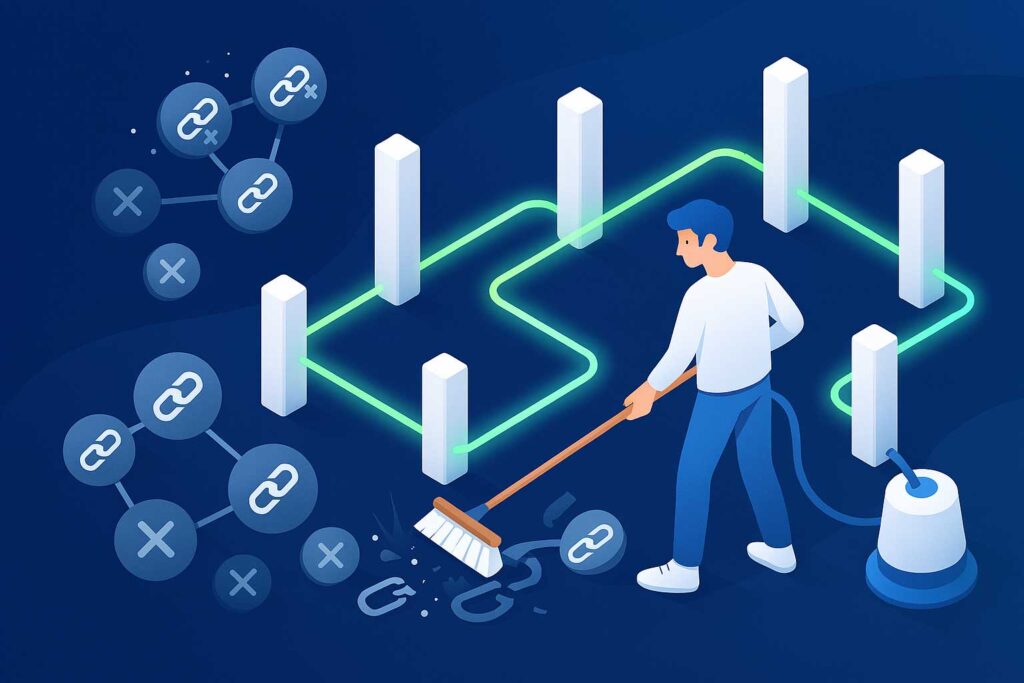What Are Toxic Links in SEO?
Toxic links are harmful backlinks that point to your website from spammy, irrelevant, or low-quality sites. These links can hurt your Google rankings, trigger manual penalties, and reduce your domain authority.
Google’s algorithm evaluates the quality, relevance, and trustworthiness of backlinks. If your site has too many toxic links, it may be flagged as manipulative or spammy — leading to ranking drops or even deindexing.
Quickly identify harmful backlinks with our Toxic Link Checker Tool.
Why Cleaning Up Toxic Links Is Critical for SEO
Cleaning up toxic backlinks is a vital part of maintaining a healthy link profile and ensuring your SEO performance remains strong.
Removing or disavowing bad backlinks can lead to:
- Improved search engine trust
- Higher organic visibility and rankings
- Recovery from Google penalties
- Better domain authority and reputation
- Reduced risk of algorithmic suppression
Perform a full Backlink Audit to analyze the quality and source of all incoming links.
How to Identify Toxic Links
Toxic backlinks share common patterns that make them harmful to your SEO. These include:
- Links from spammy or irrelevant websites
- Links with exact-match anchor text spam
- Links from link farms or automated directories
- Paid or exchanged backlinks without proper context
- Links from sites penalized by Google
Run a complete analysis using our Domain Authority Checker to assess link trustworthiness.
How to Clean Up Toxic Links — Step-by-Step
Step 1: Perform a Comprehensive Backlink Audit
Use Small SEO Tool’s Backlink Checker to gather a complete list of all domains linking to your site.
Export the report to identify suspicious or low-quality links that could be harmful.
Start now with our Backlink Checker Tool for a detailed backlink report.
Step 2: Evaluate Link Quality
Review each link manually or with automated tools to check:
- Domain Authority (DA) and Page Authority (PA)
- Relevance to your niche
- Anchor text usage
- Spam score and IP location
Use our Website SEO Audit Tool to identify low-quality referring domains.
Step 3: Contact Webmasters to Remove Bad Links
Reach out politely to the webmasters of the sites hosting harmful links. Request removal or update of the backlinks that point to your domain.
This step can take time but helps build a cleaner, natural link profile.
Optimize your contact outreach using our Email Extractor Tool to find webmaster details quickly.
Step 4: Use Google’s Disavow Tool
If certain links cannot be removed manually, prepare a disavow file listing those domains or URLs and upload it through Google Search Console.
This signals Google to ignore those toxic backlinks when evaluating your site.
Create your disavow file easily using our Disavow File Generator.
Step 5: Monitor and Reassess Regularly
Toxic backlinks can reappear due to scraping or automated spam.
Perform routine backlink audits to ensure your link profile remains clean and natural.
Track your SEO improvements over time using our SEO Ranking Tracker.
Common Causes of Toxic Backlinks
- Buying backlinks from low-quality sites
- Engaging in link exchange schemes
- Using automated backlink generators
- Negative SEO attacks by competitors
- Old or abandoned link-building campaigns
Prevent future toxic links by analyzing competitors’ backlink strategies with our Competitor Analysis Tool.
Here you get answer for
- “How to Identify and Clean Up Toxic Backlinks Safely”
- “Best Tools for Removing Harmful Links and Recovering from Penalties”
- “Step-by-Step Guide to Disavow Toxic Links in Google Search Console”
- “How Toxic Backlinks Affect SEO Rankings and Domain Authority”
- “Recover from Google Penguin Penalty by Cleaning Toxic Links”
Evaluate your website’s reputation after cleanup using our Website Reputation Checker.
SEO Benefits of Cleaning Up Toxic Links
✅ Prevents Google manual and algorithmic penalties
✅ Improves domain trust and link authority
✅ Boosts organic keyword rankings
✅ Enhances overall website performance
✅ Creates a sustainable, long-term SEO foundation
Boost your domain health after cleanup using our Domain Authority Booster Guide.
Common Mistakes to Avoid When Cleaning Up Toxic Links
- Disavowing good links accidentally
- Failing to monitor new backlinks
- Relying only on automated tools
- Ignoring manual outreach before disavow
- Not re-uploading updated disavow files regularly
Audit your links monthly using our Broken Link Checker to catch new issues early.
Advanced Link Detox Techniques
- Use Link Quality Filters: Segment links by authority, anchor text, and spam score.
- Focus on Relevance: Keep links only from topically aligned sites.
- Check IP Diversity: Avoid multiple links from the same server or network.
- Combine Tools for Accuracy: Cross-check data from multiple backlink analyzers.
- Rebuild Healthy Links: After cleanup, replace toxic backlinks with quality guest posts or citations.
Generate high-quality backlinks post-cleanup using our Get Quality Backlinks Guide.
Frequently Asked Questions (FAQ)
Q1: What are toxic backlinks?
Toxic backlinks are links from spammy, irrelevant, or penalized sites that can negatively impact your SEO rankings and domain authority.
Q2: How can I identify toxic links?
Use backlink audit tools like Small SEO Tool’s Toxic Link Checker to analyze the quality and source of incoming links.
Q3: Is it necessary to disavow toxic links?
Yes, especially if they can’t be manually removed and are affecting your SEO performance or causing penalties.
Q4: Can cleaning toxic links improve rankings?
Absolutely. Once harmful links are removed or disavowed, Google may restore your rankings and trust signals over time.
Q5: How often should I clean my backlinks?
Perform a backlink audit every 2–3 months to maintain a clean and authoritative link profile.
Conclusion
Cleaning up toxic backlinks is an essential step toward building a strong, penalty-free SEO foundation.
Toxic links can silently destroy your visibility, credibility, and rankings — but with a well-planned link detox strategy, you can recover faster and stronger.
By using Small SEO Tool’s free backlink management utilities, you can easily detect, analyze, and remove bad backlinks, helping your website stay compliant with Google’s best practices and maintain long-term ranking stability.
A clean backlink profile means a healthier website, higher domain authority, and stronger SEO success.



